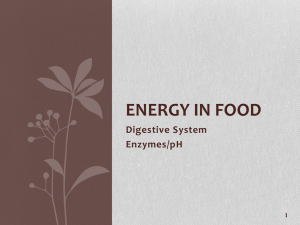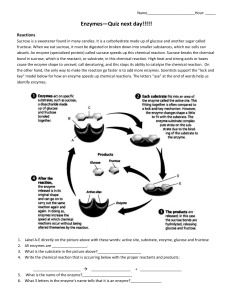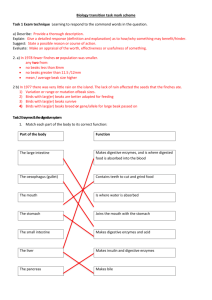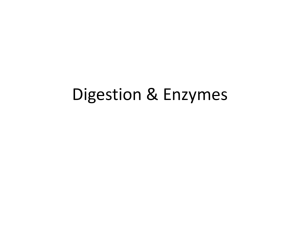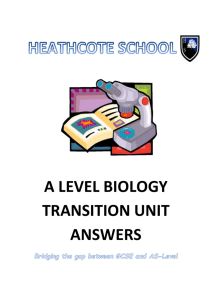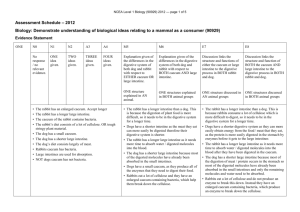Ecology - MsJuo2011
advertisement
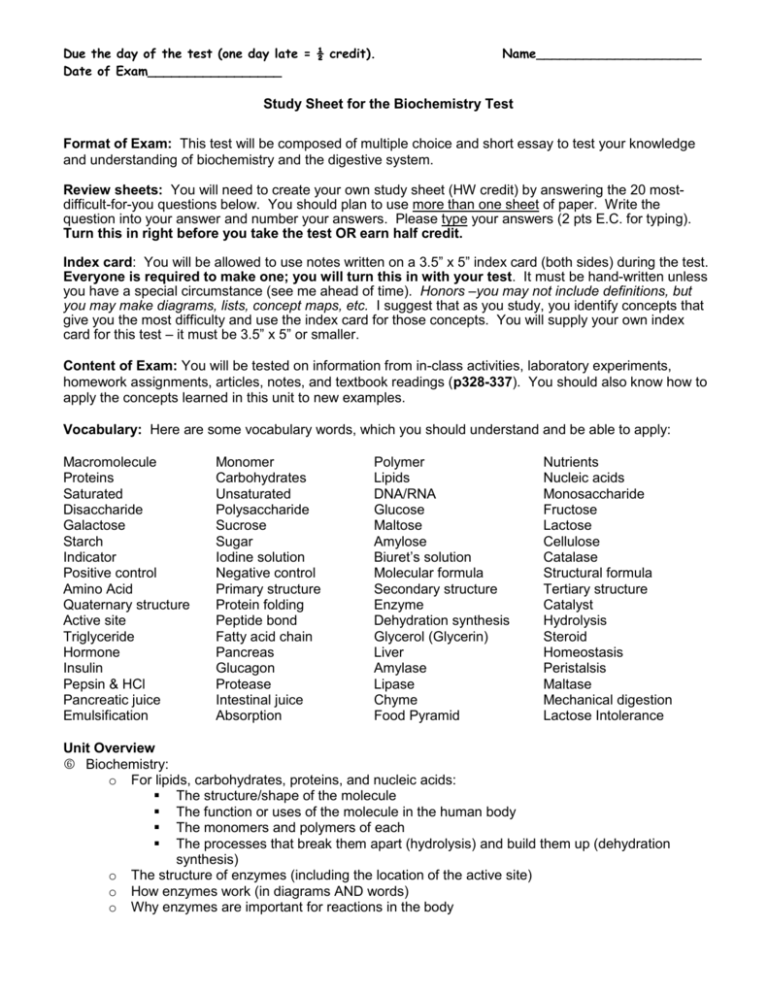
Due the day of the test (one day late = ½ credit). Date of Exam_________________ Name_____________________ Study Sheet for the Biochemistry Test Format of Exam: This test will be composed of multiple choice and short essay to test your knowledge and understanding of biochemistry and the digestive system. Review sheets: You will need to create your own study sheet (HW credit) by answering the 20 mostdifficult-for-you questions below. You should plan to use more than one sheet of paper. Write the question into your answer and number your answers. Please type your answers (2 pts E.C. for typing). Turn this in right before you take the test OR earn half credit. Index card: You will be allowed to use notes written on a 3.5” x 5” index card (both sides) during the test. Everyone is required to make one; you will turn this in with your test. It must be hand-written unless you have a special circumstance (see me ahead of time). Honors –you may not include definitions, but you may make diagrams, lists, concept maps, etc. I suggest that as you study, you identify concepts that give you the most difficulty and use the index card for those concepts. You will supply your own index card for this test – it must be 3.5” x 5” or smaller. Content of Exam: You will be tested on information from in-class activities, laboratory experiments, homework assignments, articles, notes, and textbook readings (p328-337). You should also know how to apply the concepts learned in this unit to new examples. Vocabulary: Here are some vocabulary words, which you should understand and be able to apply: Macromolecule Proteins Saturated Disaccharide Galactose Starch Indicator Positive control Amino Acid Quaternary structure Active site Triglyceride Hormone Insulin Pepsin & HCl Pancreatic juice Emulsification Monomer Carbohydrates Unsaturated Polysaccharide Sucrose Sugar Iodine solution Negative control Primary structure Protein folding Peptide bond Fatty acid chain Pancreas Glucagon Protease Intestinal juice Absorption Polymer Lipids DNA/RNA Glucose Maltose Amylose Biuret’s solution Molecular formula Secondary structure Enzyme Dehydration synthesis Glycerol (Glycerin) Liver Amylase Lipase Chyme Food Pyramid Nutrients Nucleic acids Monosaccharide Fructose Lactose Cellulose Catalase Structural formula Tertiary structure Catalyst Hydrolysis Steroid Homeostasis Peristalsis Maltase Mechanical digestion Lactose Intolerance Unit Overview Biochemistry: o For lipids, carbohydrates, proteins, and nucleic acids: The structure/shape of the molecule The function or uses of the molecule in the human body The monomers and polymers of each The processes that break them apart (hydrolysis) and build them up (dehydration synthesis) o The structure of enzymes (including the location of the active site) o How enzymes work (in diagrams AND words) o Why enzymes are important for reactions in the body Digestion: o Structures of the digestive system and their functions (mouth, esophagus, stomach, small intestine – including duodenum, large intestine) o Where each molecule (lipids, carbs, proteins) is broken down and which enzymes break it down (the only enzymes whose names you need to know are pepsin and amylase) Journals: Molecular Modeling (balls/sticks activity kit) (J3-1), Calculating Nutrients in Fast Food (HW worksheet) (J3-2), Enzyme Structure and Function (cut-outs glued to paper) (J3-3), Protein Folding (foam stick with side chains) (J3-4) Labs: What is in the Food You Eat? (testing organic nutrients) (L3-1), Catalase and Hydrogen Peroxide (Enzyme Action lab - liver/ potato lab) (L3-2), You Are What You Eat (Glucose digestion Extra Readings: What Does Science Say You Should Eat? (food pyramid); Lactose Intolerant; In Protein Folding, Clues to Many Diseases Study Questions: Here are some questions on content. If you are able to answer all of these correctly and thoroughly, you will be in good shape for the exam. Don’t forget to type your answers. 1. 2. 3. 4. What is a monomer? Give one example for each of the macromolecule types. Write the molecular formula for a molecule of glucose. Draw the structural formula for the following molecules: glucose, amino acid, glycerol, fatty acid Circle and label the following groups on the above amino acid in #3: variable (R) group, carboxylic acid group, amino group. 5. What is the difference between a saturated and unsaturated fatty acid? 6. Is it better to consume unsaturated fatty acids or saturated fatty acids - why? If you wanted to eat unsaturated fats, what food would you eat? 7. What indicator did you use to identify protein? What change in color did you see? Name 2 substances that contain protein. 8. What indicator did you use to detect starch? What color change did you see? Name 2 substances that contain starch. 9. How would you detect the presence of lipids? 10. What is hydrolysis? Write a short explanation AND draw an example (yes, the structural formulas for the reactant(s)/ product(s) – you get to choose whether you do protein, carb, or lipid!) 11. What is dehydration synthesis? Write a short explanation AND draw an example (yes, the structural formulas for the reactant(s)/ product(s) – you get to choose whether you do protein, carb, or lipid!) 12. You combine 2 amino acids to make a bigger molecule – what is this process called? What is the product called (a specific name)? 13. What four molecules are needed to build a triglyceride molecule? 14. Name and describe the four different levels of protein structure – use a T chart as shown below. 15. Structure Description 16. How do catalysts help chemical reactions? 17. What is an enzyme (define)? What type of macromolecule are most enzymes made of? What is a substrate? What is an active site and where is it found? 18. Describe how an enzyme works. 19. List 5 characteristics of enzymes. 20. What would happen to enzyme activity if you heated the enzyme (to an optimal level)? 21. What is happening to the enzyme itself when you “overheat” it? 22. What would happen to the activity of enzymes if you cooled the enzyme? Why? 23. What would happen to the activity of an enzyme if you lowered the pH? Why? 24. What would happen to enzyme activity if you increased the surface area of the substrate? Why? 25. How do we obtain the building blocks necessary for life? How do we obtain energy? 26. Why is digestion necessary? 27. Which organ in the human digestive system could be considered the “main organ of digestion”? Why? 28. What is the role of teeth in the mouth? 29. What is digested in the mouth? What is the enzyme and what glands make the enzyme? 30. What happens in the esophagus? (That is, how does food move through the digestive system?) 31. What is digested in the stomach? Describe what conditions are like in the stomach. What is the name of the contents of the stomach? 32. What is made in the liver and stored in the gallbladder? What does this substance do? 33. The pancreas is important in the digestive system. Why? 34. Name 3 substances digested and absorbed in the small intestine. 35. What is the name of the structures on the surface of the small intestine? What is the role of the structures named? 36. Describe three things that happen in the large intestine. 37. On the diagram below, label the location of digestion in the human digestive system of carbs, lipids, and proteins. (For this question, you do not need to draw the digestive system onto your word document – you can simply do this right on the diagram on this packet). Also, try to name all the digestive system organs by heart (you don’t need to do this for the review sheet). Staple your answers to the back of this sheet when you turn it in.
